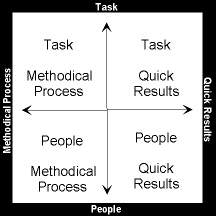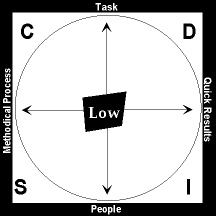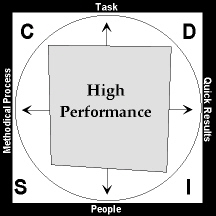|
|
Colorful Leadership
Harnessing the
Power
|
|||||||
|
||||||||
|
Stop Trying To Fix People Why we
don't always make sense to each other Have you ever been held in high regard one day and
low regard the next day, even though you were the same person in both
situations? This happens to all of us. One person may see your
ability for getting quick results as a positive strength while another
person sees you as shooting from the hip. One person may see your
ability for building great processes as a positive strength, and
someone else may see you as constantly aiming but rarely firing. When two people approach work in the same way, they
make sense to each other. When
they don’t, they may not understand each other, and they may see one
another in a negative way. Shooting from the hip and taking time to
aim are both important, but each is appropriate at different times.
Both approaches are valuable and essential for long-term success, but we
tend to be invalidated when we approach things differently from other
people. This leads to the real problem: other people are trying to
fix us, and though it is hard to admit, we are trying to fix others, too.
To understand personality differences that lead to
conflict, we use a team map. Four elements make up the team map, and
each person’s mixture of these elements predicts behavior, work style,
and potential conflict. Let’s look at two of these elements, methodical process and quick
results. Methodical
Process----------------------------------------Quick Results Quick
Results Methodical
Process The first group will say, “Just do it” and the
second will say, “Do it the right way.” Can you imagine the
frustration they cause to each other?
But they are both right; we need both speed and accuracy. The other two elements in the team map are task
orientation and people orientation. Task
--------------------------------------------------------- People Task
Orientation People
Orientation These are the two extremes, and most of us fall
somewhere in between, but we tend to be on one side or the other.
For example, the task person on a project will say, “Let’s get these
three things done, and the client should like it.” The people
person will say, “I just had a great meeting with the client, and he
suggested three things that will make him happy.” Notice the
slight difference. They both want to do three things and make the
client happy; the difference is the order. Both approaches are
valid, but each will frustrate the other.
1. Task and
Quick Results The proof of
the pudding is in the eating, not the cooking. 2. People
and Quick Results The pudding
must be decorated for a special occasion and be the center attention on
the table. 3. People
and Methodical Process Follow the
recipe, distribute equal portions, and everyone is happy with a
tried-and-true product. 4. Task and
Methodical Process Make the
pudding with the highest-quality ingredients, a recipe tested in labs, and
FDA approved. There is good material that helps us understand
these four quadrants. We like the DISC model because it is quick and
meaningful when you use it to profile a team and build a team map.
The American Management Association (AMA) DISC Survey labels our four
quadrants in the following way: Directing, Influencing, Supportive, and
Contemplative.
All of these people want to get the job done, but
they take different approaches. The problem is that we try to fix
people: we waste too much time trying to get others to use our
approach. For example the type
D (task-oriented, quick results) will say, “Just do it!”
They overcome problems of the past and get people into the present.
Details will be handled when we get to them, rather than talking about
them in advance. You might say they handle details in real-time.
The key word is what, “What needs to get done?” The type I
(people-oriented, quick results) will say, “Let’s have fun getting the
job done.” Fun does not necessarily mean goofing off; fun can mean
finding creative ways to delight the customer. The type I person wants to inspire the whole team to look good, which
pays off when they need important things like funding and upper management
support. The key word for them is who,
“Who is working on this?” The type S
(people-oriented, methodical process) will say, “This is the way we do
it here.” They have great confidence in the approach because they
have a process that is clear, dependable, and predictable. Keeping
conflict at a minimum is extremely important to the type
S people because they truly believe that conflict muddies the water
and distracts from the path to success. They keep us on track.
The key word for them is how,
“How are we going to do it?” The type C
(task-oriented, methodical process) will say, “Do it right the first
time.” They like data, not opinion, so their first efforts will be
towards research. They pay particular attention to what happened in
the past so that they can avoid repeating mistakes. Type
C people protect us from disaster because they verify and test;
nothing gets missed. While the other types (D, I, and S) are asking
what, who, and how, the type C is thinking, "Why?"
Low-Performance
Teams
Each DISC style has its shortcoming. For
example, let’s look at the sales process. You might think type I people would be perfect for sales because they like people.
Their problem is that they are so focused on people that they lose sight
of the task, and they often neglect the necessary follow-through.
You might think that type D
people would be good at sales because they are results-focused.
Unfortunately, they look for quick results, which may not be there.
They might neglect to build rapport with the people who are buying.
Type S people are great at
follow-through and they do well with people, but they don’t really like
initiating and taking chances. The type C is looking to crack the code and build the perfect sales
process, but they might never leave the office and meet with customers;
they want to do such a great job that customers will call them. When we recognize the shortcoming of each
individual and try to fix the person, we make things worse.
For example, we might try to fix the type
D people by telling them to calm down and be patient. We tell
them that in the long run if they follow the step-by-step process, they
will do a better job; in addition, they need to pay more attention to
people’s feelings. Type D
people will become frustrated with this approach because they see short
cuts that are missed and everything takes longer than it needs to.
The result is that they lose interest in the project, and the great
passion they had for achieving results is gone. To fix the type
I people, we tell them how to get organized. They try, but
quickly become discouraged. Initially, they may have great success,
but they see no result or reward for being organized, and in the meantime
all the fun is gone and creativity is reduced. Their goal had been
to delight the customer, and now they are working to satisfy the bean
counters. The type S
people don’t need fixing. They follow the processes, do what is
expected, and look out for one another. The problem is that changing
times and shifting goals constantly frustrate them. We tell them to
get with the program, but we don’t tell them how; then we write a bad
review because they won’t get going. We might say that the type
C people have to become more outgoing, so we assign them to new
activities such as organizing a company picnic, giving presentations, or
cold-calling on prospects. The result is frustration because the
real work is not getting done; they want the time to focus on task and do
a good job. High
Performance Teams We have conducted our workshop, High Performance Teams, at large companies around the country.
Regardless of the group, we see the same thing happen when we map a
group’s DISC styles. We ask the team to find the person with the
lowest score in each quadrant and plot it on the team map. Most
often, we see a low score in each quadrant. If we focus on these
weaknesses and spend energy on fixing them, we will create a
low-performance team, a bunch of losers. If they work hard, they
might be able to bring themselves up to average, but it will still be hard
to sustain that position. Next, we ask the team to find the person with the
highest score in each quadrant, and we plot that on the team map.
There is almost always someone high in each behavior type. It
becomes obvious that if each person were to do what he or she does well,
everyone would be doing well in some area.
Looking at the team map, we see complementary
skills. Our task-oriented people (D,
C) make sure we stay focused and do it right; our people-oriented
teammates (I, S) help people
stay motivated and make sure everyone feels he or she is an important part
of the process. Our results-oriented people (D,
I) keep things moving quickly, always toward the end goal; our
process-oriented people (S, C)
make sure things are done right and in the right order. We have just stated the obvious, but we miss it all
the time. It’s easy to say, but it’s hard to do because it’s
not natural to willingly accept divergent styles. We are most
comfortable with our own style, and the other styles often don’t even
make sense to us. If you want high performance from your team, make
the choice to step away from fixing people. Everyone is good at
something. Find that something and figure out how to put it all
together.
Copyright © 2003 Bill Kuehn and Steve Wille |

 Let’s
put the four elements together and see how people might behave in each of
four quadrants.
Let’s
put the four elements together and see how people might behave in each of
four quadrants.

